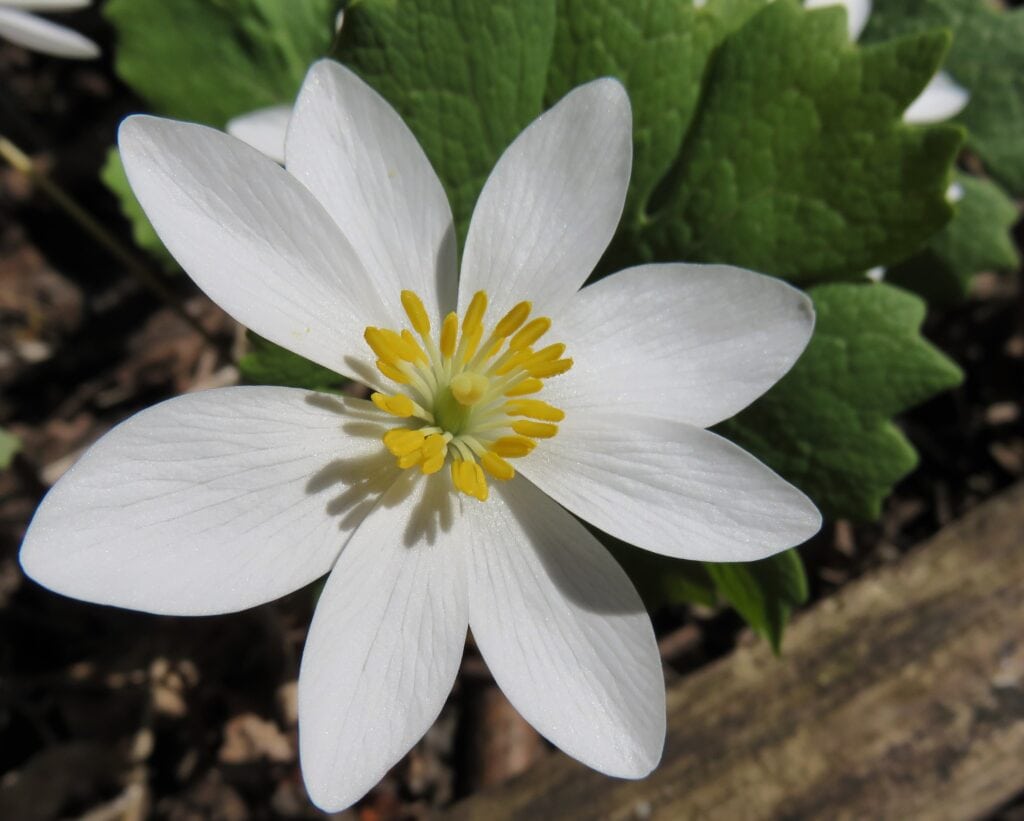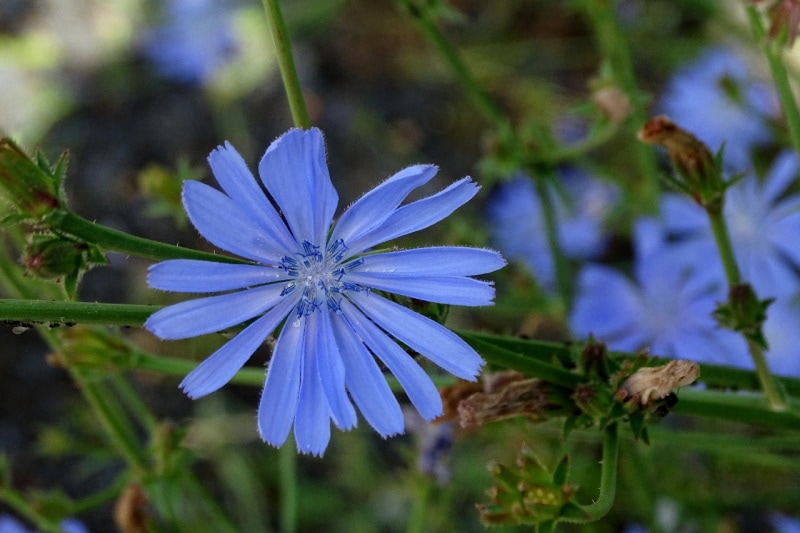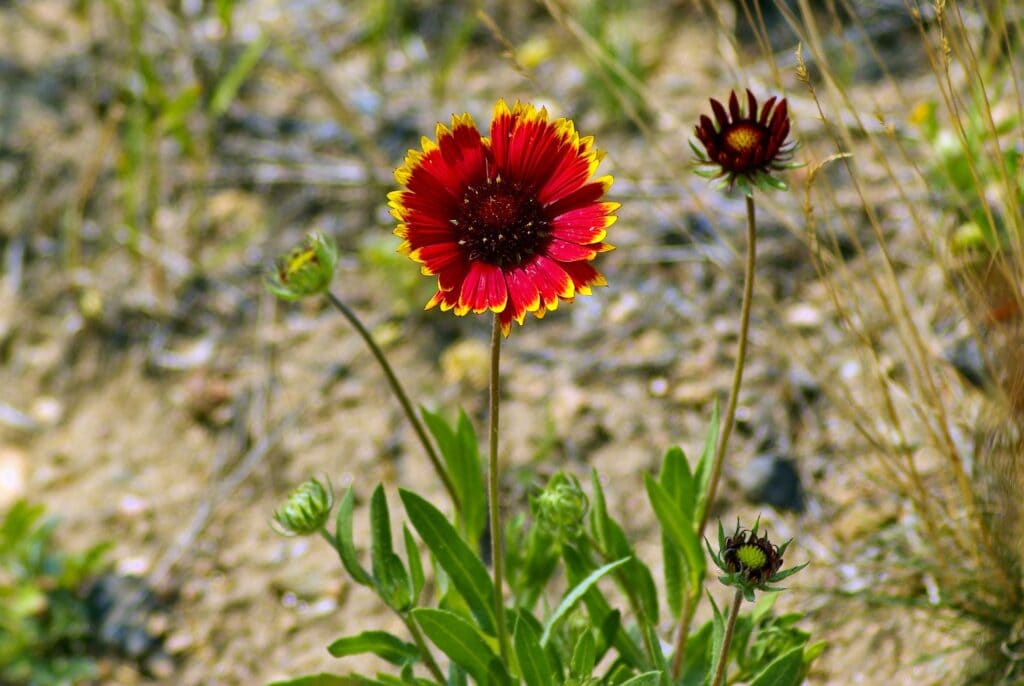14 Wildflowers That Grow In Georgi: Identification Guide (With Pictures)
-
Pete Ortiz
- Last updated:
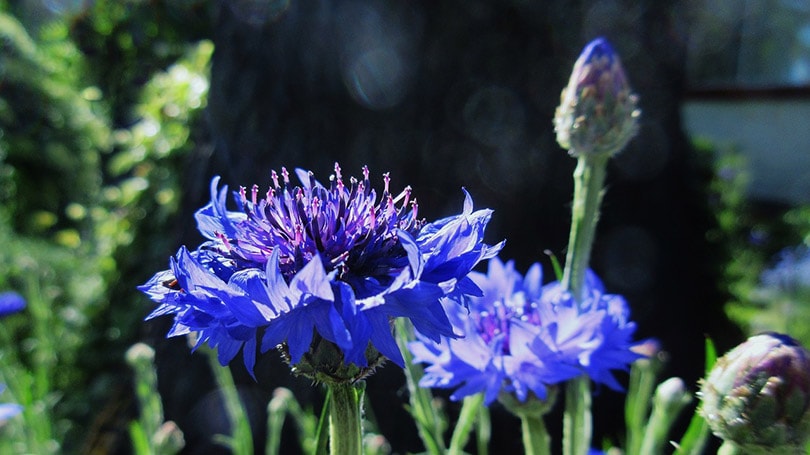
Georgia’s highways offer an extra-special driving experience, thanks to the hard work of eco-conscious government efforts. Since 1974, the DOT’s Wildflower Program has been beautifying roadsides across the state. As the weather warms, sunny highway medians transition from lush green grass to dazzling rainbows of perennial wildflowers, luring beneficial pollinators and creating a visual delight for travelers.
Wildflowers are a central feature of Georgia’s identity, whether dotting its busiest roadways or growing within its deepest forests. Discover the Peach State’s unique floral wonders with this identification guide for 14 of Georgia’s wildflowers.
The 14 Wildflowers that Grow in Georgia
1. Blue Violet (Viola sororia)

| Bloom Period: | March-May |
| Height: | 6”–10” |
| Flower Color: | Blue, purple, pink, white |
Georgia is home to almost 30 types of violets, representing nearly half of the 60–70 species across North America. Arguably the most popular variety, the common blue violet, is a low-growing perennial featuring heart-shaped green leaves and conspicuous five-petaled flowers on individual stalks.
The one-inch blue-violet blooms consist of two upper petals and three often smaller lower petals. Looking down the throat, you’ll see white hairs spanning two bottom petals alongside colorful veining.
2. Bloodroot (Sanguinaria canadensis)
| Bloom Period: | March-April |
| Height: | 10”–14” |
| Flower Color: | White |
Walking among the leaves in deciduous hardwood and floodplain woods, you may be able to identify the emerging bloodroot even before it blooms in early to mid-March. A single flower and leaf grow on separate fleshy stems alongside one another from an underground rhizome. The veiny, gray-green, and multi-lobed leaf wraps around the flower stem, finally spreading when the bloom opens.
Flowers open in the sun and close at night, living for only a few days before shedding petals. When fully open, a two-inch-wide bloom presents numerous stunning white petals surrounding a golden-yellow stamen cluster.
3. Chicory (Cichorium intybus)
| Bloom Period: | June–September |
| Height: | 3’–5’ |
| Flower Color: | Blue |
Chicory is a common sight along roadsides, meadows, and other disturbed sites, with leaf growth resembling a similarly weedy flower, the dandelion. Long, lanceolate basal leaves, each up to 10 inches long, form a rosette from which a flower stalk emerges after its first season. Flower branches ascend the stalk, and each holds smaller lanceolate leaf clusters at the base.
The late-blooming plants produce several flowers along each branch. Blooms are 1–1.5 inches wide, consisting of numerous papery, strap-shaped petals surrounding dark blue anthers. A closer look at the petals reveals five small teeth at their tips, creating a forked appearance.
4. Periwinkle (Vinca minor)
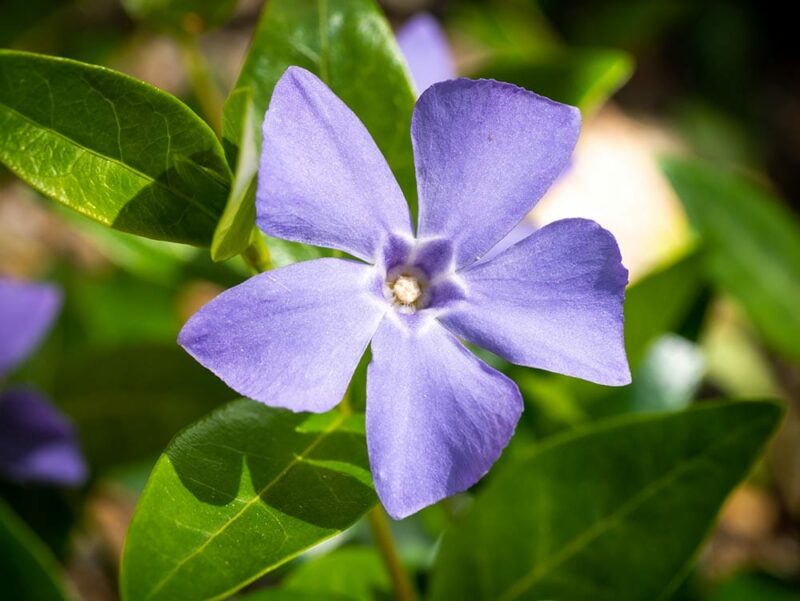
| Bloom Period: | March-May |
| Height: | 4”–6” |
| Flower Color: | Blue, purple |
The low-growing common periwinkle is a popular groundcover for tricky shaded spots. It’s a hardy and often invasive plant that presents a gorgeous array of foliage and flowers for year-long interest. Glossy, lush evergreen leaves line the vine with shimmering arrowhead shapes. Bluish purple flowers emerge in early spring sporting a pinwheel of five petals.
5. Georgia Aster (Symphyotrichum georgianum)

| Bloom Period: | September-November |
| Height: | 1.5’–3’ |
| Flower Color: | Purple |
The Georgia aster is, unfortunately, a rarer sight these days as development has pushed it out of its native open areas in mixed forests and rocky woodlands. As one of the biggest asters in Georgia, its late-blooming flowers grow up to 3 inches wide, with numerous purple rays accompanying a cluster of minute white and purple disc flowers in the center.
6. Bachelor’s Button (Centaurea cyanus)
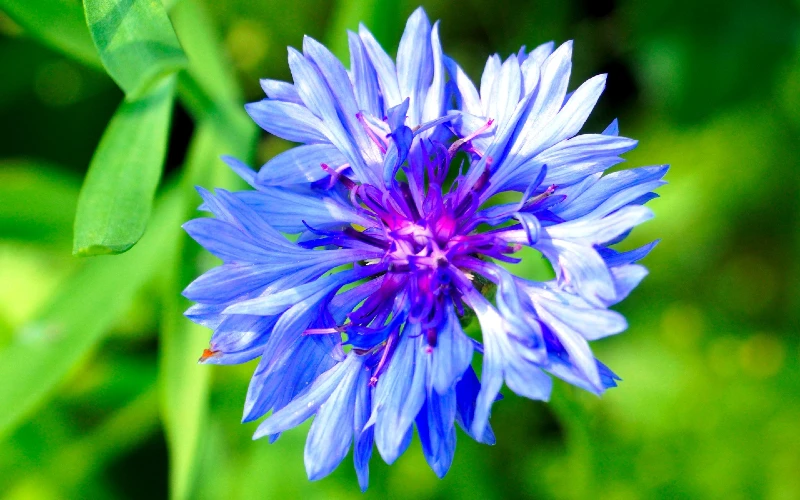
| Bloom Period: | May-August |
| Height: | 3’–4’ |
| Flower Color: | Blue |
Bachelor’s button is a familiar annual wildflower along Georgia roadsides and filling fields and disturbed sites. Atop each stem sits a 1-inch flowerhead with fluted outer disc flowers arranged around the inner florets. Though typically a striking blue when they bloom in late spring through summer, you may see mixed in whites, purples, and pinks, with the inner florets often contrasting the outer petals.
7. Trout Lily (Erythronium americanum)

| Bloom Period: | March-May |
| Height: | 6”–8” |
| Flower Color: | Yellow |
The diminutive and short-lived trout lily is one of the first Georgia wildflowers to appear in its moist woodland habitats. A single drooping yellow flower grows at the end of a short stalk, with six petals curling back to reveal the long brown stamens.
Identifying the trout lily starts with its distinct leaves, of which there are two when it matures. Reaching up to 8 inches long, its smooth elliptical leaves have a mottled green and maroon pattern. Trout lily plants can also feature a single leaf but will only grow a flower when there are two.
8. Forget-Me-Not (Myosotis scorpioides)
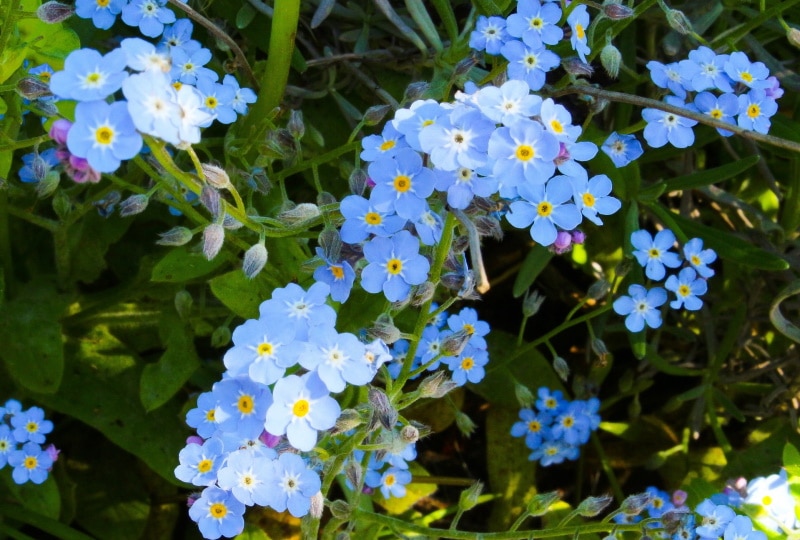
| Bloom Period: | May-September |
| Height: | 6”–12” |
| Flower Color: | Blue |
Sprays of light blue forget-me-nots bring a delicate charm to Georgia’s moist woodland and meadow habitats. Branching clusters, or cymes, of long-lasting small flowers sit at the end of curling stalks resembling a scorpion’s tale in the early blooming period. As the flowering season progresses, the stalks unfurl.
The glossy semi-evergreen foliage alternates along the plant, with each leaf measuring up to 4 inches long in an oblong shape. Each flower is only ¼ inch in diameter, but the sky-blue petals complementing bright yellow centers make them stand out regardless.
9. Swamp Milkweed (Asclepias incarnata)
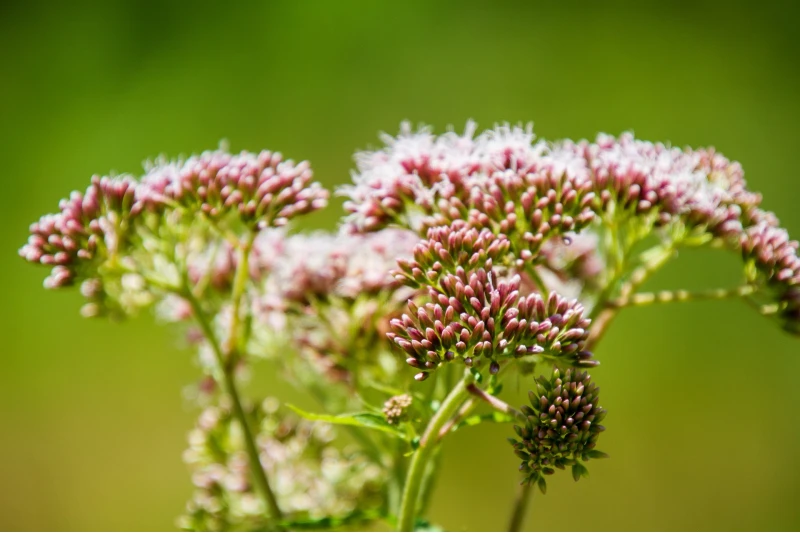
| Bloom Period: | June-October |
| Height: | 2’–6’ |
| Flower Color: | Pink |
The swamp milkweed presents grand displays of deep purple-pink blooms at the end of its branching stems. Look for it offering its vibrant flower clusters through the summer in Georgia’s wet swamps, floodplains, and marshes. Opposite lanceolate-shaped leaves measuring 3–6 inches long run up the stem. In full sunlight, you may find purplish tinges in the foliage as the growing season ends.
10. Bee Balm (Monarda didyma)

| Bloom Period: | May-September |
| Height: | 2’–4’ |
| Flower Color: | Red |
The native bee balm’s striking scarlet head welcomes the arrival of summer in Georgia’s open woods and meadows. The unkempt blooms consist of tight, tubular flowers in 2-inch clusters, making for an unexpected pollinator lure. Oval leaves positioned up the stem grow up to 4 inches long, often including a downy underside and minor serrations along the edge.
11. Flame Azalea (Rhododendron calendulaceum)
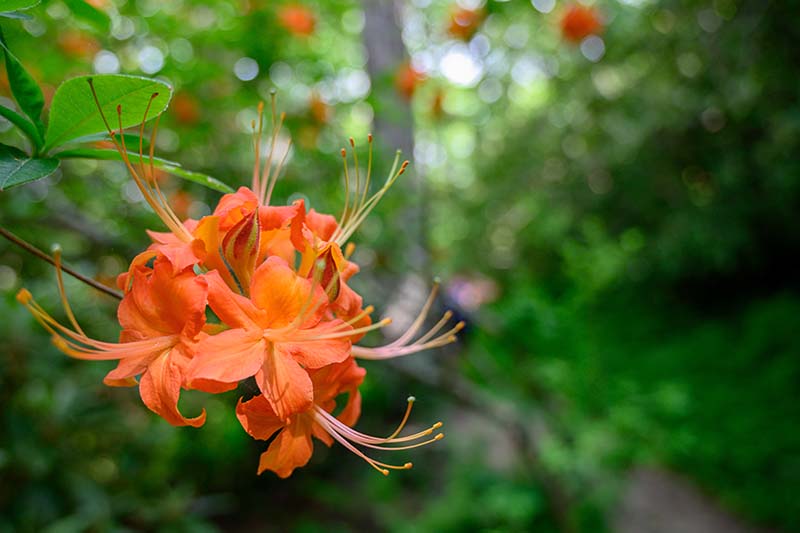
| Bloom Period: | May-September |
| Height: | 2’–4’ |
| Flower Color: | Red |
Georgia’s state wildflower may be the non-specific “native azalea,” but to many, there’s no finer representative than the intense orange-red flame azalea. The tall shrubs deliver their showy 2-inch blooms in mid-spring, appearing primarily in the mountains on rocky woodland hillsides.
The funnel-shaped blooms grow in eye-catching clusters of 5–10 flowers across the bush, which can grow over 10 feet tall. The glossy oval leaves alternate along the deciduous azalea’s branches, transitioning from a deep green to a soft yellow-red color in the fall.
12. Indian Blanket (Gaillardia pulchella)
| Bloom Period: | March-November |
| Height: | 12”–24” |
| Flower Color: | Yellow and red |
The hardy and attractive blanket flower can flower for long periods, offering a unique visual splendor year-round in certain parts of its expansive North American range. In Georgia, you’ll find it growing abundantly in dry, open meadows across coastal regions.
The annual grows hairy stems up to 2 feet long, with slender alternate leaves lingering towards the plant’s base. Capping the stem is a single flower 2–3 inches wide with numerous red-orange rays meeting at a hefty center with brown disc flowers. With its highlighted yellow tips, the Indian blanket’s already vibrant fiery form becomes immediately identifiable with a stunning starburst appearance.
13. Dutchman’s Breeches (Dicentra cucullaria)
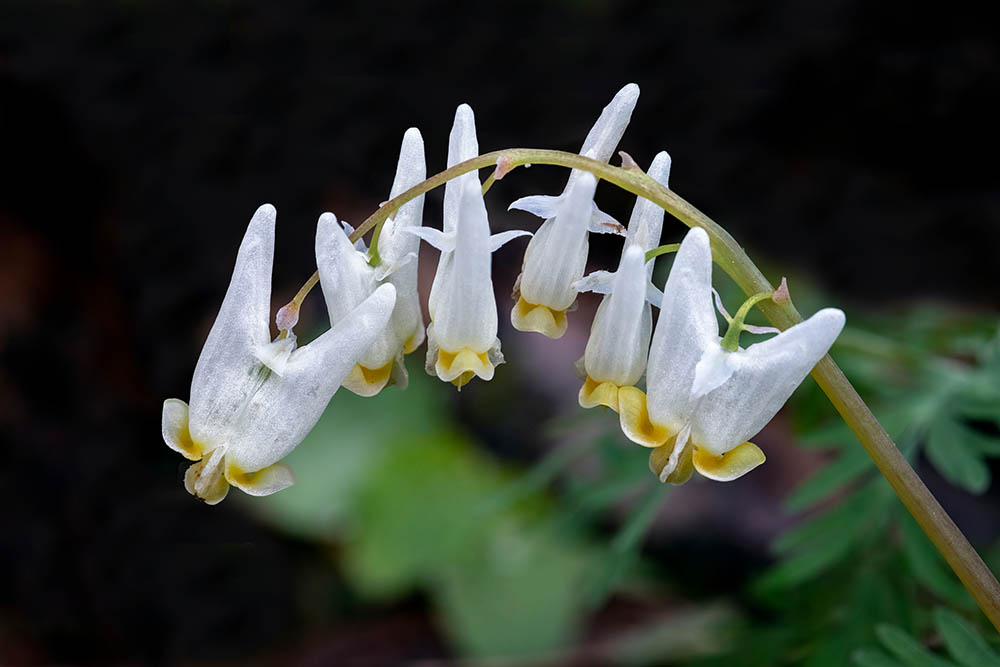
| Bloom Period: | March–May |
| Height: | 10–12” |
| Flower Color: | White |
From the deep-cut leaves to the pants-like look of the flowers supplying the plant’s name, the Dutchman’s breeches is one of Georgia’s most all-around unique wildflowers. Masses of compound leaves provide a fern-like appearance at the plant’s base. Leafless stalks travel over the leaves, carrying the flowers for a short period in spring before going dormant by summer.
The fragrant white flowers cluster on the stalk, forming lines of blooms resembling upside-down trousers. Growing in deciduous woods and rocky ravines, the flowers attract early spring bumblebees. Unfortunately, they wilt quickly after picking, so you won’t be able to hold onto them if you find the tidy lines of blooms in the wild.
14. Pink Lady’s Slipper (Cypripedium acaule)
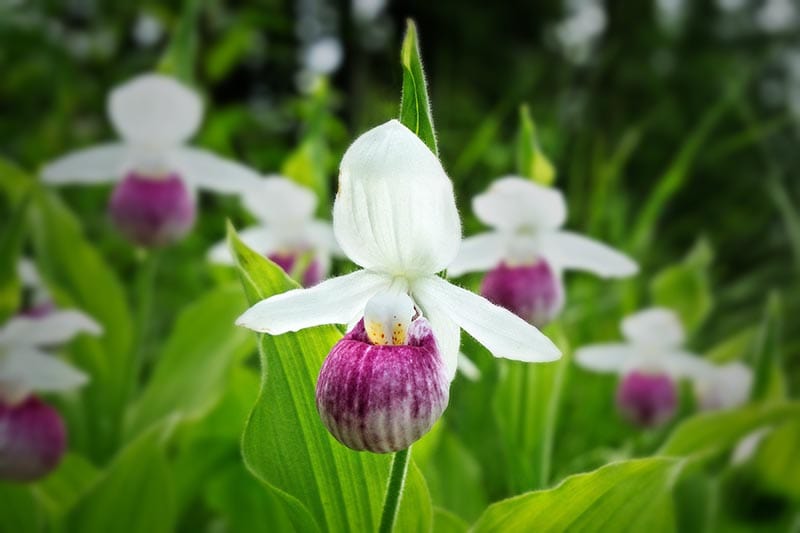
| Bloom Period: | April–June |
| Height: | 6–15” |
| Flower Color: | Pink |
As a showy orchid, the pink lady’s slipper is one of Georgia’s most treasured wildflowers, residing in its northern mountainous regions and mixed forests around pines and other conifers. Flowering occurs in mid-spring and often creates abundant expanses of blooms in its ideal growing grounds. Though it isn’t rare, the flower is protected in Georgia due to its specific soil needs and difficulty in transplanting.
Two large opposite basal leaves introduce the pink lady’s slipper’s upright leafless stalk culminating in a drooping pink pouch about 2–3 inches long lined with veins and almost resembling a human heart. Accompanying sepals and petals are typically yellow-brown or maroon.
Conclusion
Georgia’s magnificent array of wildflowers beautifies landscapes and inspires gardeners from the coast to the Appalachian Mountains. Some are rarer than others, but each delights in its unique way, enhancing the Peach State’s singular character and year-round natural intrigue. Note the season the next time you take in Georgia’s great outdoors, and keep a sharp eye for your favorite blooms.
Featured Image Credit: june88, Pixabay
Contents


